- 12 MIN READ
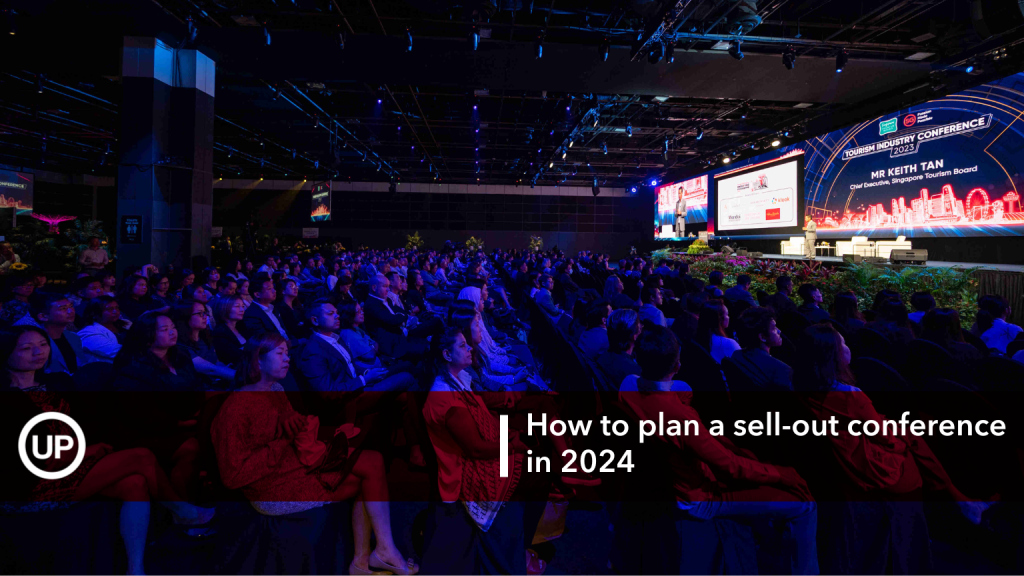
Initial planning phase
1. Define your goals and objectives
2. Determine your target audience
3. Define your budget
4. Select your sponsors
5. Craft your conference theme
6. Choose your venue
7. Select your conference date (or dates)
Main planning phase
8. Work out your conference programme
9. Start marketing your conference
10. Delegate roles and responsibilities
11. Plan your event technology
12. Find your speakers
Final planning phase
13. Rehearse your conference programme
14. Send reminders to your conference attendees
During your conference
15. Track your conference attendance
After your conference
16. Analyse your performance and follow up with attendees

Conference planning is a gargantuan task, whether it’s your first time or not. With so many moving parts to manage (often simultaneously), even the most adept event managers are bound to get overwhelmed at some point.
Selling out a conference is even harder. From conceptualisation to execution, how can you persuade your target audience to register for your conference? Read our step-by-step conference planning guide to learn how you can drum up excitement for your conference?
Initial planning phase
1. Define your goals and objectives
When planning for a successful conference, your first priority should be to set your goals. Your conference is more likely to attract your target audience if the conference programme and messaging are aligned with your goals and objectives.
Here are some starting questions to ask yourself:
- What do I want to achieve with this conference?
- How many attendees do I want to attract to my conference?
- What insights and/or knowledge do I want my conference attendees to leave with?
- What is my desired return on investment (ROI)?
Establish your key performance indicators (KPIs) from the outset, so your conference planning checklist stays aligned with your core objectives. Here are some potential KPIs to track:
- No. of qualified leads
- No. of RSVPs
- No. of conference registrations
- No. of new registrations
- No. of returning registrations
- Cost per acquisition
- Social media engagement metrics
Likes, shares, comments, mentions, etc.
Always remember to define your goals from the beginning. These will help you identify the metrics you should use to measure the success of your conference.
2. Determine your target audience
All successful conferences share one common factor: a properly defined target audience profile. This will help you to identify key pain points and specify which of these you can solve, then craft your conference message accordingly.
Here are some thought starters to help you prepare your target audience profile when you’re planning for your conference:
- What are the demographics of my target audience?
Age, gender, occupation, income bracket, location, etc. - What interests do they have? What do they hope to achieve from attending your conference?
Eg. expanding their knowledge, opportunities to network, meeting like-minded individuals, etc. - Will my target audience be interested in what my conference has to offer?
What topics should your conference cover? Does it align with what your target audience is interested in learning about?
There are many ways to determine your target audience, but we’ve picked out some strategies you can consider:
- Conduct market research
Consider including surveys, interviews with individuals who potentially fit your target audience profile and focus groups when conducting your market research. This will give you a clearer perspective on potential challenges, pain points, interests and goals you can target when planning your conference. - Create potential audience profiles
Audience profiles help you get a deeper understanding of who you’re looking to attract to your conference. This allows you to determine your exact target audience groups, optimise your approach, create more personalised campaigns and ultimately gain a competitive advantage when promoting your conference to your audience. - Leverage feedback from past attendees and your customers
If you’ve held conferences before, this is an opportunity to make use of feedback from past conference attendees and customers. Find out what attracted them to your conference, what knowledge or insights they wanted to get, and whether your conference was able to satisfy their overall objectives, so you can repeat that same success.
3. Define your budget
Fixing a number for your budget helps you to prioritise your expenditure while minimising unnecessary expenses.
Follow these four steps when setting your conference budget:
- Set your financial goals
Your financial goals depend on multiple factors, but ultimately it comes down to how much profit you want to make. Decide the profit margin you want to achieve, then work out your expenses and revenue to see how you can fine-tune your financial objectives accordingly. - Determine your fixed and variable costs:
Fixed costs refer to any costs that usually remain constant throughout your conference planning process. Examples: venue rental, equipment, IT, speaker fees, marketing costs
Variable costs refer to any expenses that may increase or decrease depending on your conference turnout. Examples: food and catering costs, staff salaries, guest favours. - Pinpoint your revenue sources
There are multiple sources you can consider for your conference, such as advertising, sponsorships and management fees. Weigh the advantages and disadvantages of each revenue source, and think about which will work best for your conference. - Create a budget proposal
Now that you’ve laid out your budget requirements, put together a proposal to inform your stakeholders about your projected budget and your expected expenses. This document should include the purpose of your conference, information about similar conferences, potential ways for your budget to go over, your target ROI, as well as any contingency plans for your conference.
4. Select your sponsors
Finding sponsors is one of the simplest ways to offset your conference expenses. Sponsorship funding boosts your spending power, which allows you to enhance your conference offerings.
Here are some examples of sponsorships for conferences:
- Exhibitors
The most common type of sponsorship, where brands pay a certain amount of money in exchange for a booth at your conference. - Financial sponsorship
Where sponsors pay you in exchange for publicity at your conference. This can come in the form of on-site branding (signages, banners, etc.), promotional material (videos, social media, etc.), granting them official partner status, and more. - Gift-in-kind sponsorship
Similar to a financial sponsorship, but sponsors provide something else instead of cash. These may include funding prizes or certain perks, such as venues or equipment. - Media sponsorship
Usually media outlets, these sponsors provide support in helping to advertise your conference, either by funding it or by providing ad placement for it. - Promotional partnership
Similar to a media sponsorship, promotional partners (such as social media influencers) will instead help to promote your conference on their own channels.
Sponsorship opportunities can arise when they are mutually beneficial. Sponsors provide you with funding for your conference, and in return, you provide a new avenue for them to reach new audiences and attract new customers.
5. Craft your conference theme
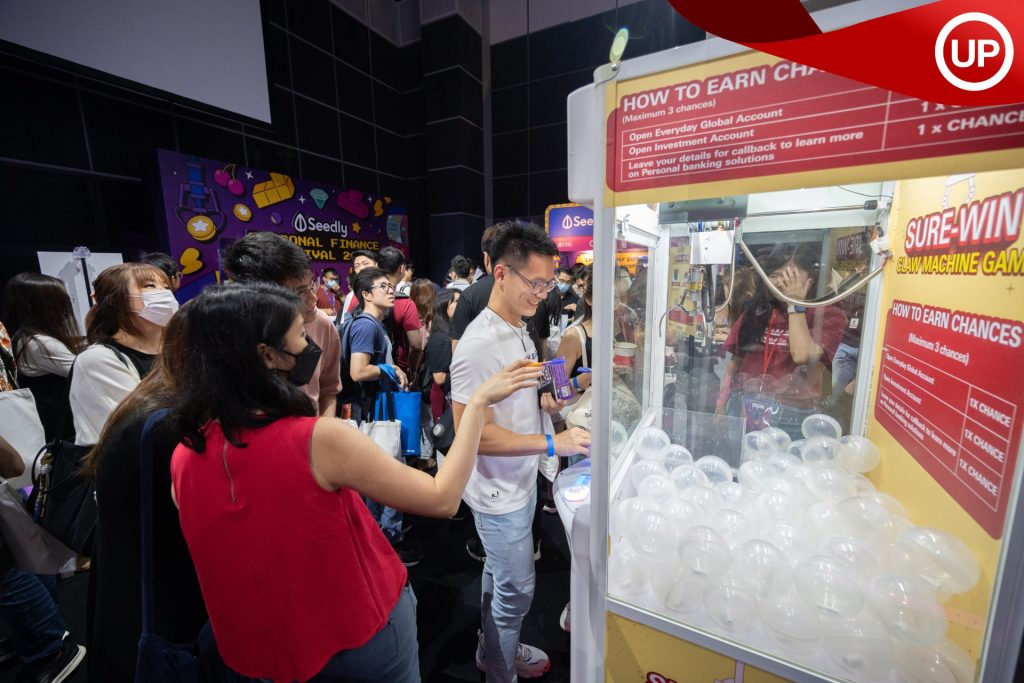
An attendee tries his hand at a claw machine in the HSBC Bank exhibition booth at Seedly Personal Finance Festival 2023.
A simple idea can turn into an unforgettable conference theme if you incorporate interactive storytelling effectively. By incorporating interactive storytelling into your conference theme, a simple idea can turn into an unforgettable experience for your conference attendees.
Hazel Lim, our Assistant Director of Event Experience, spoke about the importance of crafting an impactful theme for Seedly Personal Finance Festival 2023:
When the team at Seedly first approached us with the ‘arcade’ theme, we immediately saw the opportunity to get the audience involved and take a more active role during the conference. We conceptualised and designed an arcade-style activity zone that boasted a total of 17 exhibition booths, and worked with exhibitors to set up games that one would normally find at an arcade, such as basketball and claw machines. This really helped to bring out the arcade concept at the conference, and elevate the theme into a truly unforgettable experience for audience members.
Hazel Lim
Assistant Director, Event Experience
Unearthed Productions
6. Choose your venue
If you’ve opted for an in-person or hybrid format in the previous step, locking down your venue becomes your next priority.
You’ll need to consider many factors, such as:
- How many attendees do I want to accommodate?
- Will it be a single- or multi-track conference?
- Can I align my conference theme with the venue?
- What amenities will I require?
- How much time do I have to book my venue?
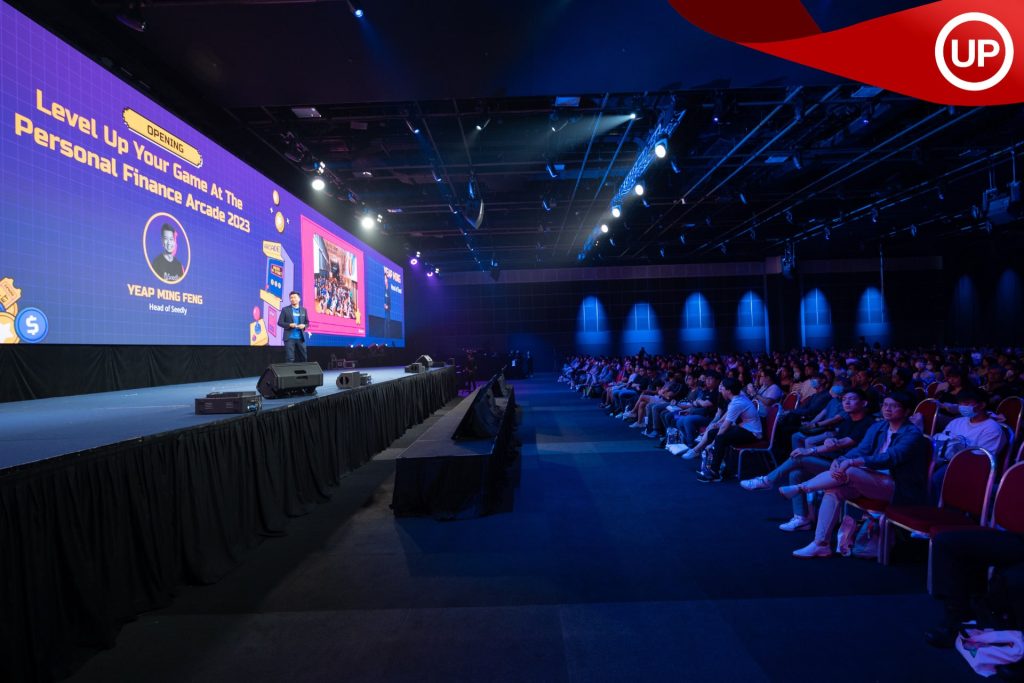
Yeap Ming Feng, Head of Seedly, delivers his opening speech at the Seedly Personal Finance Festival 2023. Over 3,000 attended the conference, which was held at Engage Theatres 2 @ Suntec Singapore.
We’ve planned conferences that have catered to crowds as large as over 3,000 attendees, so we know how important it is to work with venues that can meet your capacity requirements. That’s why by partnering with some of the world’s leading MICE destinations, we get priority access to a wide selection of venues that can support bigger crowds.
Here are some venues in our network that can be used for larger conferences:
- Engage Theatres 3 (capacity: 5371)
- Engage Theatres 2 (capacity: 3933)
- Engage Theatres 1 (capacity: 1494)
- Orchard Hotel Singapore (capacity: 1500)
7. Select your conference date (or dates)
Check if your venue is available on your desired date (or dates, if your conference will be held over multiple days). Try to do this early, so you can start marketing your conference as soon as possible.
Main planning phase
8. Work out your conference programme
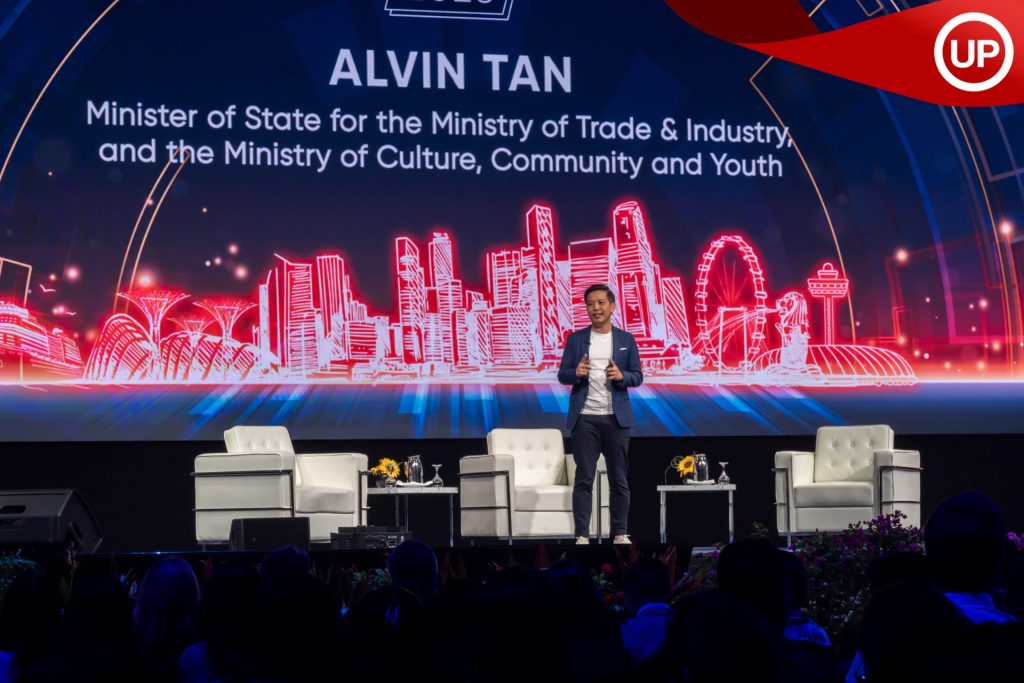
Alvin Tan, Minister of State for Trade and Industry and Minister of State for Culture, Community and Youth, delivers the opening address at the Tourism Industry Conference 2023.
Your conference can either consist of a single-track or multi-track programme. Here’s what you can consider for your conference:
Single-track
Opening address
Setting the conference agenda
Speaker timeslots
Break times
Networking sessions
Closing address
Multi-track
Opening address
Setting the conference agenda
Speaker timeslots
Break times
Networking sessions
Breakout sessions / fireside chats
Closing address
Your programme will ultimately determine whether your target audience decides to attend, so remember to plan your schedule according to the specific pain points and interests of your audience.
9. Start marketing your conference
Marketing will be one of the trickiest aspects of your conference planning. The reach of your marketing efforts and the way it’s promoted to your target audience, will determine whether your conference sells out or not.
Here are some ways to kick off your marketing:
- Setting up a microsite or landing page
Your microsite or landing page should include key information such as: your conference dates, location, programme, list of key speakers or performers, official sponsors, floor plan, contact information, photos and videos of previous years’ editions or teaser photos and videos for first-time conferences, and FAQs. - Announcing and marketing your conference on social media
Take advantage of your social media channels (Facebook, Instagram, LinkedIn, etc.) to announce and promote your conference, and be sure to include the same key information on your microsite or landing page. - Using email marketing
Send out eDMs to your email database to notify them about your upcoming conference. We recommend making use of an email sequence (a series of emails that are automatically sent out at specified intervals). Email sequences help to keep potential attendees engaged while increasing the number of opportunities for them to register for your conference.
(Skip to point #14 for more information on how to schedule your email sequence.) - Sending out press releases
Notify key media outlets about your conference, and only include the most essential details so the media outlets are more likely to put out an article for your conference.
It takes time to generate enough hype to sell out your conference, so remember to begin your marketing efforts as early as possible so word can spread around in time for your conference.
10. Delegate roles and responsibilities
Now that your agenda is ready, it’s time to assign roles. You will require the support of a wide array of skill sets and areas of expertise from all your team members.
Here are some common roles and responsibilities to include:
Planning and Strategy
Event Manager
Creative Director / Strategist
Account Manager
Marketing Manager
Public Relations Executive
On-site Management
Venue Manager
Stage Manager
Floor Manager
Showcaller
Event Moderator
Talent Management
(for speakers, performers, etc.)
Event Technology Management
Camera Director
Lighting Designer
Teleprompter Operator
Sound Engineer
Ancillary Support
Check-ins
Security
Catering
Wayfinding
Set-up and tear-down
Remember to secure any external personnel required and finalise your staff list ahead of time, in order to avoid last-minute staffing emergencies. If you require additional human resources to meet your needs, you may also check for available personnel services that your conference and venue partners may offer.
11. Plan your event technology requirements
Your event technology requirements heavily depend on your conference format. In-person, hybrid and virtual conferences all have their own must-haves, so it’s important that you plan specifically for each of them.
Regardless of your conference format, there are some tech requirements that apply across the board. Here are some of our recommendations:
- Marketing tools
Websites, social media, promo codes, UTM links, etc. - Management tools
Ticketing, registration, customer relationship management (CRM) tools, project tracking, etc. - On-site event technology
LED walls, self check-in kiosks, etc. - Broadcasting
Live streaming, video recording, video on demand (VOD), etc. - Analytics
Attendance tracking, data collection, data analysis, etc.
Artificial Intelligence (AI) is also something you may want to consider for your conference. It allows you to create a new level of precision for each attendee, and when done right, it offers exciting opportunities to personalise your content.
One example dates as far back as 2016, during a collaboration between the Masters Tournament, one of four major global men’s golf tournaments, and IBM Watson, a powerful AI system. An AI-powered chatbot was used to engage with attendees and online viewers, providing real-time updates, answering questions and providing suggestions on which players to watch. Another example is Dreamforce 2020 by Salesforce, where AI-powered chatbots answered attendees’ questions and followed up by making personalised virtual session recommendations.
12. Find your speakers
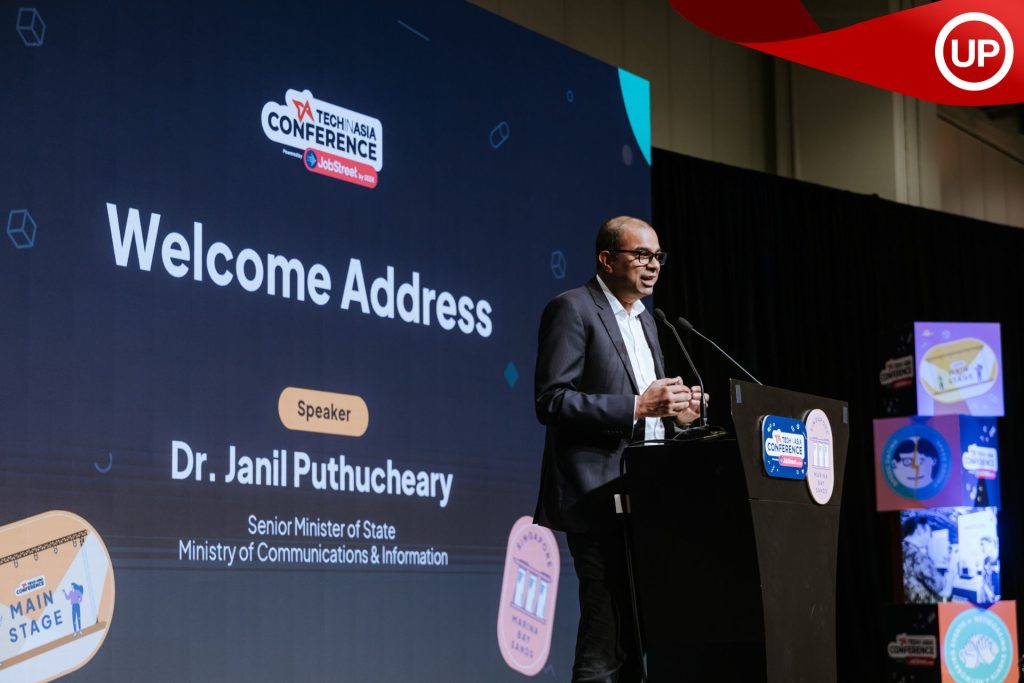
Dr. Janil Puthucheary, Minister of State for Communications and Information and Minister of State for Health, delivers his welcome address at Tech In Asia Conference 2022.
Inviting noteworthy speakers to your conference is an effective way to generate hype and interest in your target audience. Your speakers will attract attendees who want to tap into their knowledge and insights, and attendees looking for networking opportunities with fellow industry professionals. They also help to expand your reach by promoting your conference to their own followers.
Here are three ways to find speakers for your conference:
- Check out keynote speakers at similar conferences
- Research organisations and businesses related to your conference topics
- Work with an agency to get connected with suitable speakers
Once you’ve shortlisted your speaker candidate selection, here’s a simple checklist you can use to finalise your choice:
- Is this speaker available to attend my conference? If not, will this speaker be able to attend virtually via live stream?
- What is the track record of this speaker? Does it align with my conference programme and topics?
- Can this speaker contribute to the goals and objectives of my conference?
- Can this speaker introduce relevant information, insights and knowledge to my target audience?
- Will my target audience be interested in learning from this speaker?
Final planning phase
13. Rehearse your conference programme
Go through a full rehearsal with all parties involved. This lets you iron out any kinks in your conference flow, and helps you to ensure that everyone has the tools and resources they need to smoothly execute the conference programme. It also helps your speakers and performers feel more confident during the actual conference.
Your rehearsal should cover the following:
- Testing equipment
Do a test run of all your audio, visual and lighting systems. This will naturally include all the relevant personnel, such as your Camera Director, Lighting Designer, Teleprompter Operator and Sound Engineer. - Programme flow
This ensures that your conference runs smoothly, and gives you the opportunity to identify any potential areas for improvement in your conference programme, such as time or personnel management. - Conduct practice speeches
Set aside some time for your speakers to rehearse. Try your best to give each speaker enough time to rehearse their full speech at least twice; this will allow them to spot any problems and gain confidence for the actual conference.
Try to do this a few days in advance if possible, so you’ll have time to fix any issues in time for your conference.
14. Send reminders to your conference attendees
Remember to send out reminders to your attendees. We recommend that you do this by setting up an email sequence. (1 week before, 3 days before, 1 day before, etc.) so you can generate enough hype to increase sign-ups.
Keep your reminders short and simple. Here’s what you should include:
- A synopsis of your conference
What is it about? Why should it matter to your attendees? - Your conference theme and message
What can your attendees stand to get from the conference? - Date, time and location
- Your conference programme
- Any featured speaker or performer
- FAQ section
This should address key concerns your target audience may have about your conference.
During your conference
15. Track your conference attendance
Assign a member of your team to track how many attendees show up for the event, and create a list of those who didn’t turn up, so you can prepare to follow up with them after the conference. This will help with your analysis and measure the success of your conference.
After your conference
16. Analyse your performance and follow up with attendees
Go through what went well in your conference, and what can be improved in the future. Include the following in your post-conference report:
- Find out who turned up (and who didn’t)
Get a list of attendees who showed up, attendees who RSVP-ed but didn’t attend, and those who didn’t RSVP at all. - Get audience sentiment
Send out post-conference emails to your attendees. Thank them for coming, and include a short survey to get their thoughts on the conference. This gives you a clearer picture of how your audience felt about your conference, and can offer possible solutions for you to improve any future conferences. - Follow up with the no-shows
Don’t forget to check in once more with those who RSVP-ed but didn’t show up. Send out an email to inform them that your conference is over, and ask if there was any particular reason they didn’t attend. - Review your conference programme analysis
Hold meetings with everyone involved in the conference planning, and consolidate everyone’s feedback on the entire process. Discuss what went smoothly, what problems arose, and possible solutions for avoiding these hiccups.
Plan a sell-out conference with us today
Planning a sell-out conference is never easy. You have to manage many moving parts, such as delegating roles, coordinating resources, and scheduling multiple project flows. There may also be areas that you and your team may not be properly equipped to handle.
Work with an experienced partner that can offer tried-and-tested solutions for your next conference. Unearthed Productions is an award-winning full-service agency that specialises in crafting seamless experiences for conferences as well as many other types of events. Our track record includes attracting over 10,000 attendees to Asia’s largest tech and startup conference, bringing in over 3,000 Singapore’s largest personal finance conference, and many more.
By conceptualising specific themes that come alive through the power of interactive storytelling, we transform your conference into an unforgettable experience for your attendees.
Plan your next sell-out conference with us today!
Our Venue Partners
Suntec Singapore | Pan Pacific Singapore | Carlton Hotel Singapore | Four Seasons Hotel Singapore | NTUC Centre | M Hotel Singapore City Centre | Orchard Hotel Singapore | Garden Pavilion @ The Ritz-Carlton, Millenia Singapore | Grand Copthorne Waterfront Hotel | Bridge+ Ascent | Ola Beach Club | Changi Cove | Ngee Ann City Civic Plaza | Urban Green Rooms (Orchard Road)
